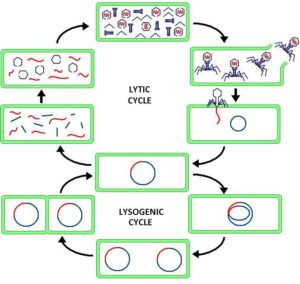I’ve had several questions about studies showing that phages can transfer antibiotic resistance. So is this true. You might be surprised by the answer.
In short, some can, some can’t.
Phages are a type of virus that can only infect very specific (matching) bacterium. They can not infect human cells, plant cells, etc. They can also only infect one specific bacterial strain, or very closely related strains. Phages that kill a pathogenic bacterium can not harm our beneficial bacteria in our microbiome.
There are two basic types of phages, “lytic” and “lysogenic”.
- Lytic – Lytic phages infect bacteria and very quickly kill their host, there is also no mingling of DNA material.
- Lysogenic – With Lysogenic phages the phage simply infects the bacteria, but does not kill it. A bacterium infected with a lysogenic phage may be infected for the remainder of its natural life. Lysogenic phages do share DNA with the bacteria.
This video (and transcript) explains things very simply (but thoroughly). As this video describes – Lytic phages are impatient, they infect the bacterium cell and reproduce within it until it explodes, or “lysis” the host cell, thus killing it. This releases all of the new phages to infect more bacterium (of the same strain. They can not infect human cells, it isn’t possible). This method does not, can not, spread antibiotic resistance.
The second method is the “patient” method, or “lysogenic”. In this method we’re “just gonna keep the host alive. And in order to sneak in and let the bacteria do its thing while it’s waiting, it’s going to combine with the host’s genetic information, so that the host really can’t tell that it’s there.” In this method it may infect the host bacterium for as long as it naturally lives. In this method, since it “combines with the host’s genetic information” it can spread antibiotic resistance.
“The key difference is that in the lytic cycle the viral DNA is maintained in a separate pocket from the cellular DNA and matures separately while in the lysogenic cycle the viral DNA is kept mixed with the celluar DNA. Another key difference is that in the lytic cycle the viruses replicate constantly which results in the eventual lysis, or death, of the host cell to release the new viruses while in the lysogenic cycle the virus replicates only with the regular cellar mechanism for reproduction and is only released through some separate outside event.” ⇒
This Wikipedia page may also help.
https://en.wikipedia.org/wiki/Lysogenic_cycle
We have both types of phages inside us, all the time. Though all of this might sound scary, it is part of nature, a very important part.
Note: The phages in the Probiotic / Prebiotic product Phage Complete are lytic phages, they kill (lyse) their host bacterium within hours of infection and do not share DNA, and thus do not (can not) spread antibiotic resistance. So in short, Phage Complete will not cause antibiotic resistance. As I like to say, “dead bacteria tell no tales”.

.
All images posted by John Herron are either "Copyrighted John Herron", or are copyrighted by someone else and are used under license. So please don’t use them elsewhere, you’ll get in trouble.

 Phage Complete comes with a full 30 day money back guarantee, for U.S. purchases this includes the original shipping charges to you!
Phage Complete comes with a full 30 day money back guarantee, for U.S. purchases this includes the original shipping charges to you!
Thank you for explaining this!